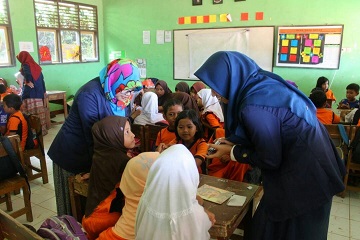Teaching History Through Educational Game

A great nation does not hide its history. President Soekarno, the first President of Indonesia, once said “Jas Merah” (stands for jangan sekali-kali melupakan sejarah – we should never hide our history). But in the modern era, the total number of Indonesian people who interested in learning history and culture are getting fewer and fewer. According to Statistics Indonesia on 2015, the percentage of people visiting historical relics or cultural heritage was only around 6.43 percent.
Understanding the nature and importance of cultural heritage is a necessary condition for making strategic decisions ensuring the proper implementation of cultural and historical heritage. Promoting the history and culture of the nation needs to be done from an early age. Cultural heritage stores the historical memory of human societies. It contributes to national identity and its scientific and cultural value makes the country recognizable and improves its image. Most thinkers, educational practitioners, and parents acknowledge that children are born helpless and need the care and guidance of adults into their teens and often beyond. Teachers and parents are encouraged to engage students from an early age and throughout childhood, to enable them to have a high sense of curiosity, so it takes parent cooperation with people around them to provide useful education on history and cultural heritage. History as art and entertainment serves a real purpose, on aesthetic grounds but also on the level of human understanding. History is the records of past human activities that are taking place on the earth surface. Teaching methods are different principles and methods that are used to instruct students in a learning environment. The methods used by a teacher will depend on the skills or information the teacher would like to convey to their students. Some of the most common teaching methods are memorization, class participation, recitation, and demonstration. Thus, we have to find ways to make learning "relevant, authentic, and valuable".
Tanti Setiowati, student of Bogor Agricultural University (IPB) who was also the Chairman of the Program Kreatifitas Mahasiswa Pengabdian Masyarakat (PKM-M Student Creativity Program for Community Development) with his team, Velia Deby Rahmawati, Erwinda Della Rizmadayanti, Retno Widuri and Yogi Priyo Pradana, made the study program by observing the elementary school in Bogor Regency, SD Negeri Dukuh 04, Galuga Village, Cibungbulang District, Bogor Regency, West Java, as the object of their study program.
The condition of SD Negeri Dukuh 04 building has been severely damaged and unfit for learning process. The classroom and teacher’ room is about 49 square meters. To landslide occurred on 2010, the second year class room which was severely damaged due to it was renovated. The border line between the Principal and teacher’s is only the plywood and bookshelves. Environmental conditions around the school are poor, garbage trash strewn around the school. There are 151 students consists of 84 boys and 67 female students in this School, and . eleven personnel, including principal, teachers, operator, and administration.
The relationships and communication between students in this elementary school is poor. The students often say harsh words to each other, but there are also taunts to vilify their own friends. The condition is very contrary to the noble character of the nation. Student awareness of education, especially history and culture is still very low. This is because learning history and culture is only done through learning in the classroom without any other supporting activities. Other factors are also due to the limited methods applied to improve student learning interest.
Therefore Tanti and her team introduced an interesting and exciting historical and cultural introduction method, “Histodu” (stands for History Education) in their community service program. The “Histodu” is educational game for teaching history, the game is best for maximum of 5 players using a set of 32 “Histodu” cards.
Players compete to collect 4 similar cards. The game is led by a mentor, to begin the game the cards must be shuffled and distributed to players 4 cards each. The first player reads one of the card’ title, another player is required to mention how many cards have the same title as the first player mentioned.
"If another player has cards with similar title mentioned by the mentor, then the first player must guess the capitalized word on the player's card. If the word is correctly guessed, the other player who has such card must pass the card to the first player and execute the punishment read by the first player. The penalty is listed under the card, for example, give an example of friendly nature. If the first player wrongly guesses or the other player does not have a card of the same title, then the first player picks up the card in the pile of cards, "said Tanti, a student from the Department of Agribusiness. The winner will be those who first collect the highest number of similar cards.
Items of program designed by PKM-M among other are Makassar (Main Kartu Sambil Belajar Main Card While Learning). Participants are introduced with “Histodu” quartet card games, game simulations, and manual sharing. Other item is Kediri (Kreativitas dan Pengembangan Diri Creativity and Self-Development), this program teach how to make pictures of Indonesian heroes created by the participants with the provided materials.
Other item the team designed is Padjajaran (Pemutaran Dua Jam Pelajaran Perjuangan Two-hour Session on National’ Struggle), during which a film depicting the struggle of our hero against colonization will be performed. The last is Singasari (Singgah Sejenak dan Pelajari Stop for a Moment and Learn), it is the outbound program which is accompanied by game which is performed while the participants spend their break time in break areas. The game is expected to foster children's character in accordance with the noble values of the nation.
"Through “Histodu” we are trying to promote history and culture as well as shaping the character of the children according to the noble values of the nation with a fun and interesting method," she explained. (Wied)



